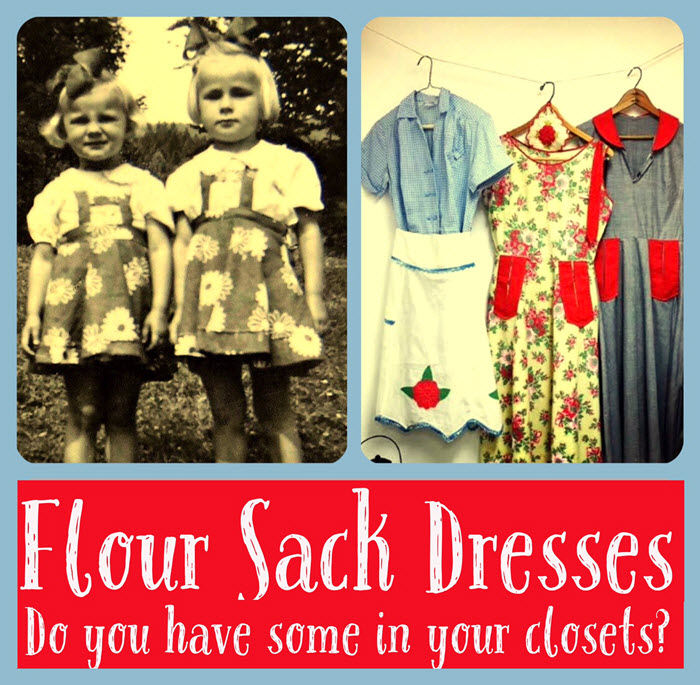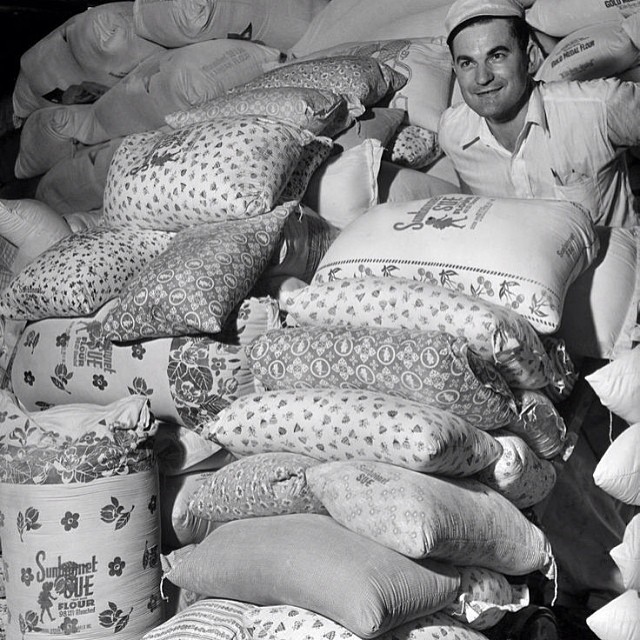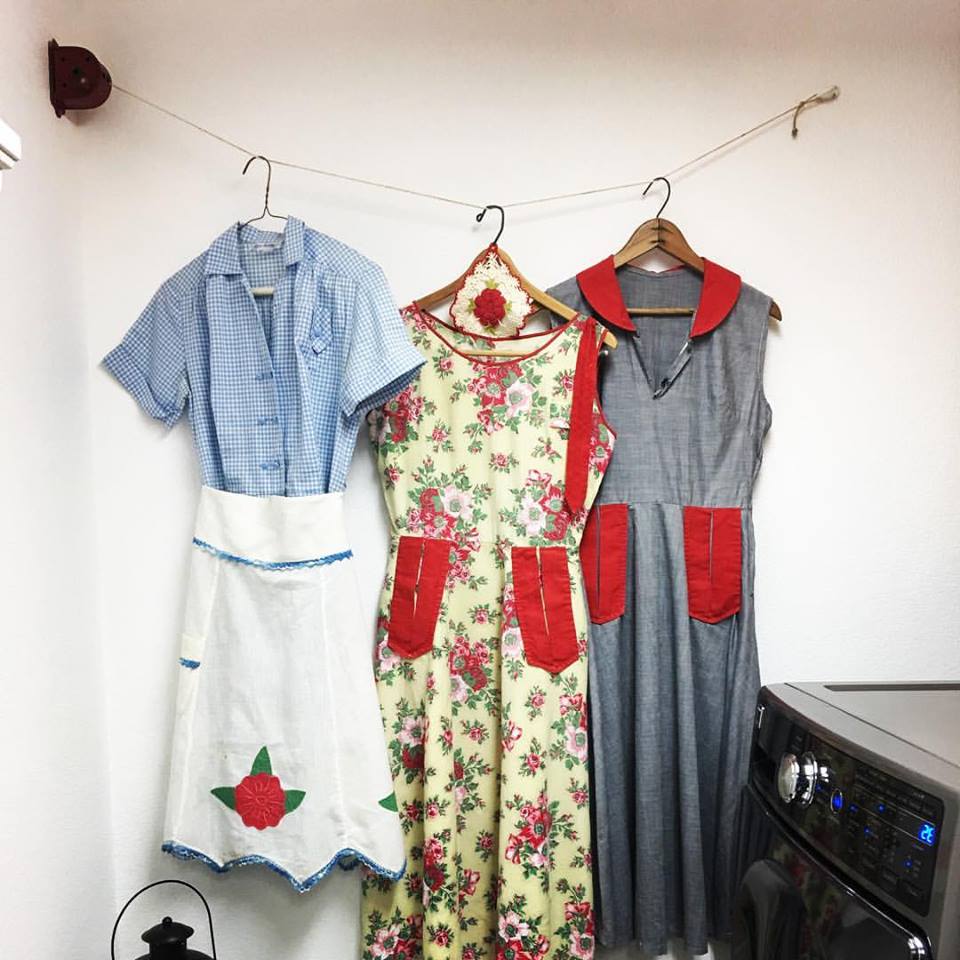Flour sack dresses show how resourceful housewives of the past “made do” with whatever was at hand. But they weren’t the only clever ones–see how savvy flour and feed companies responded to their customers’ desires for cuter sacking.

The History of Flour Sack Dresses
During the tough economic times of the Great Depression, housewives needed new ways to produce what their families needed, including clothing. So they looked around the house–and even the barn–for extra fabric they could turn into dresses, aprons, or shirts.

Female workers pose with sacks of flour in the grounds of a British mill during WWI. 1914. By Nicholls Horace [Public domain], via Wikimedia Commons. (Click to view.)
By the 1920s, these sacks had gotten a little cuter, some with gingham checked or striped patterns. So frugal housewives of the 1930s turned feed and flour sacks into everyday clothing for themselves and their families.
It didn’t take long for manufacturers of flour and feed to start printing their sacks with colors and patterns that women would want to buy. Some put patterns for dolls or stuffed animals on the bags. They even made it so you could wash out the ink so your new dress wouldn’t be a walking ad for Sunbonnet Sue flour! Newspapers and publishers also began printing patterns and ideas for getting the most out of the small yardage of a flour or feed sack.

Old photo of printed fabric flour sacks or ‘feedsacks’. Flickr Creative Commons photo, uploaded by gina pina. Click to view.
A fascinating article at OldPhotoArchive.com shows some great images of flour and feed sack dresses. And the Smithsonian’s National Museum of American History has an online article about a feed sack dress from 1959, because these didn’t go out of fashion when the Great Depression ended! According to that article, World War II caused a cotton fabric shortage. Feed and flour sack dresses again became popular.

After the war, women continued to make these dresses, encouraged even further by national sewing contests. Women even sold off their extra flour or feed sacks to others who wanted them.
Memories of Flour Sack Dresses
A woman named Denise posted a neat memory at the end of the Smithsonian article. She says:

Click to view my Facebook post about my grandma’s 1940s house dresses.
“I was born in 1951. For the first four-five years of my life, all my dresses were sewn by my paternal grandmother from feed sacks. She would layer the fabric two to three layers deep and cut the main dresses from the same pattern. She would then add different details to each dress. Some sleeveless, some with little puffy fifties sleeves, some with self collars, some with contrasting solid collars. We lived in rural north GA, but nonetheless I was teased by my parents’ friends about my feed-sack dresses. Oh how I longed for store-bought dresses. Now, oh how I long to have some of those wonderful little feed sack dresses! They weren’t thought of as precious at all, so no one ever thought to keep them!”
I think a lot of people have fond—or at least vivid—memories of old dresses like these. I do! I posted a photo of my grandma’s old house dresses from the 1930s and 1940s on Instagram. What a response from everyone there and on Facebook! My grandma’s house dresses weren’t made from flour sacks, but they’re from the same era.
Want to see some eye-candy vintage fabrics or date your own family heirloom clothing? Check out these books:
 Feedsack Secrets: Fashion from Hard Times
Feedsack Secrets: Fashion from Hard Times- Vintage Feed Sacks: Fabrics from the Farm, with over 500 colorful pictures of fabric from cloth feed and flour sacks. The book is for collectors, so it’s a price guide, too.
- Fancy to Frugal: Authentic Quilt Patterns from the ‘30s
- Dating Fabrics: A Color Guide, 1800-1960 and volume 2, Dating Fabrics, A Color Guide, 1950-2000
Care for Your Flour Sack Dresses or Other Heirlooms
 Take better care of your own family heirloom pieces, whether they are photos, vintage fabrics, documents or other objects. Get Denise Levenick’s popular book How to Archive Family Keepsakes: Learn How to Preserve Family Photos, Memorabilia and Genealogy Records. This book will help you sort, identify, and preserve your own treasured family artifacts and memorabilia.
Take better care of your own family heirloom pieces, whether they are photos, vintage fabrics, documents or other objects. Get Denise Levenick’s popular book How to Archive Family Keepsakes: Learn How to Preserve Family Photos, Memorabilia and Genealogy Records. This book will help you sort, identify, and preserve your own treasured family artifacts and memorabilia.
Disclosure: This article contains affiliate links and Genealogy Gems will be compensated if you make a purchase after clicking on these links (at no additional cost to you). Thank you for supporting Genealogy Gems!

There’s a cute children’s book about these dresses. See http://www.goodminds.com/flour-sack-flora-out-print
Looks like that book is unavailable, but I would guess a copy might be available on ebay.
I was born in our farmhouse in 1940. Oh, do I remember the dresses made from the seed sacks! Our moms could also make matching panties, to cover our underpants, for when we wanted to “twirl” on the bars on the play ground.I don’t think there were leggings or tights, then. Judy
Thanks for stopping by our place today and sharing your story 🙂